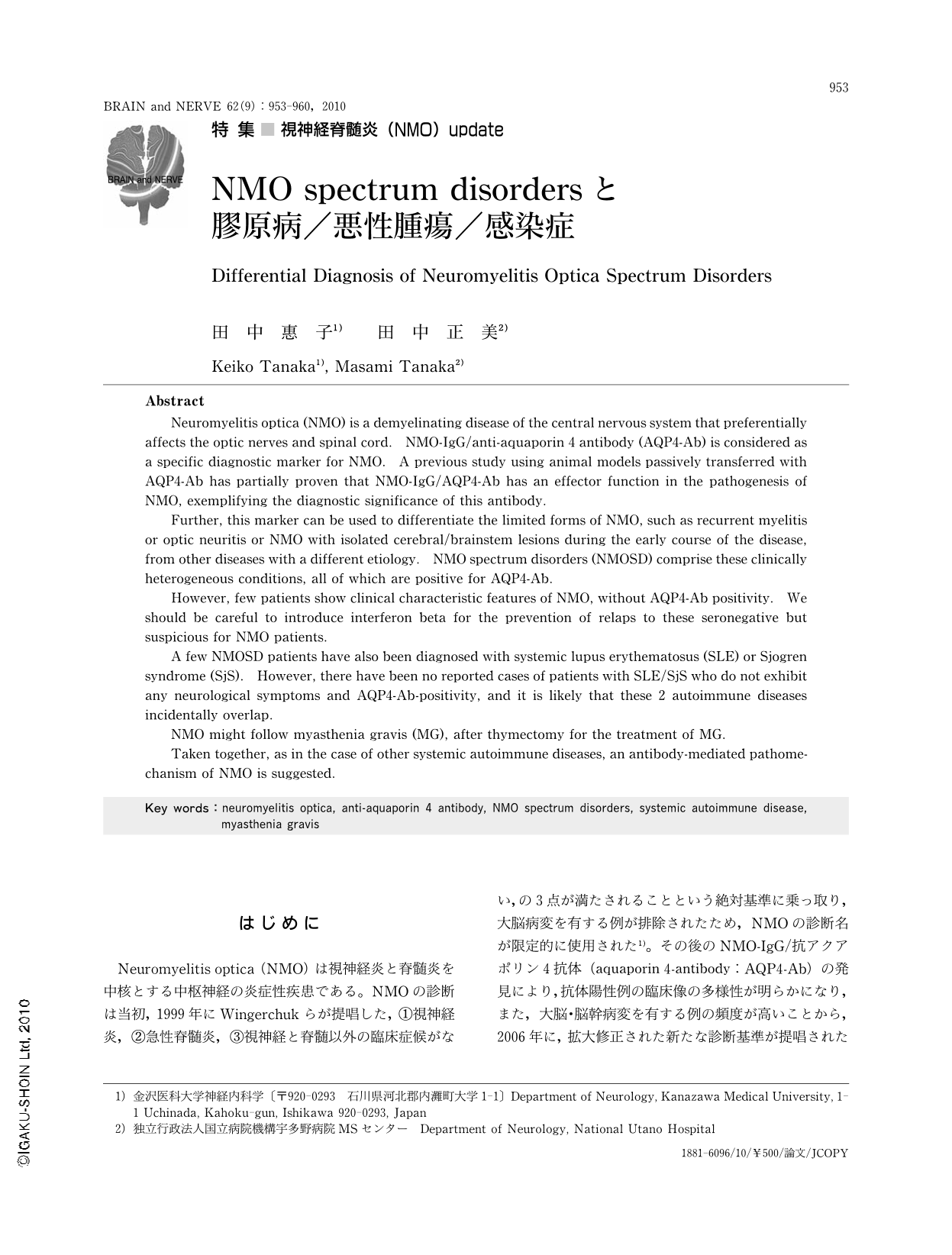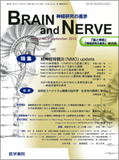Japanese
English
- 有料閲覧
- Abstract 文献概要
- 1ページ目 Look Inside
- 参考文献 Reference
はじめに
Neuromyelitis optica(NMO)は視神経炎と脊髄炎を中核とする中枢神経の炎症性疾患である。NMOの診断は当初,1999年にWingerchukらが提唱した,①視神経炎,②急性脊髄炎,③視神経と脊髄以外の臨床症候がない,の3点が満たされることという絶対基準に乗っ取り,大脳病変を有する例が排除されたため,NMOの診断名が限定的に使用された1)。その後のNMO-IgG/抗アクアポリン4抗体(aquaporin 4-antibody:AQP4-Ab)の発見により,抗体陽性例の臨床像の多様性が明らかになり,また,大脳・脳幹病変を有する例の頻度が高いことから,2006年に,拡大修正された新たな診断基準が提唱された(Table1)2)。すなわち,1)視神経炎の存在,2)急性脊髄炎,3)以下の3つの支持項目のうち最低2つを満たすもの(①MRI上,3椎体長以上に及ぶ脊髄の連続病変を認めるもの,②MRI上,MSの診断基準に合致しない脳病変を認めるもの,③血清NMO-IgG/AQP4-Abが陽性のもの)の3つの項目すべてを満たすものをNMOと診断するとした。この診断基準にも組み込まれた,NMO-IgG/AQP4-AbはNMOの特異的診断マーカーとされ3,4),現在はその病態背景も考慮して,AQP4-Ab陽性の場合,AQP4-Ab関連疾患やaquaporinopathyなどの呼称で抗体陽性群を一疾患単位と捉える傾向にある。なお,NMO-IgGは免疫組織化学での染色パターンで判断されるものであり,AQP4-AbはNMO-IgGが認識する水チャンネル蛋白そのものに反応する抗原特異的抗体を検出するものである。これまでの筆者らの検討では,両者の陽性例はほぼ一致している5)。
AQP4-Ab陽性疾患としてみた場合,診断時点での臨床像は必ずしも,上記のNMOの診断基準に合致しない場合がある。しかしながら,AQP4-Ab陽性という,特異な自己抗体を生じる共通の病態を背景にする一群としての捉え方で,抗体陽性群の多様な臨床像を包括し,NMO spectrum disorders(NMOSD)と呼称されるようになった(Table2)6)。
Abstract
Neuromyelitis optica (NMO) is a demyelinating disease of the central nervous system that preferentially affects the optic nerves and spinal cord. NMO-IgG/anti-aquaporin 4 antibody (AQP4-Ab) is considered as a specific diagnostic marker for NMO. A previous study using animal models passively transferred with AQP4-Ab has partially proven that NMO-IgG/AQP4-Ab has an effector function in the pathogenesis of NMO, exemplifying the diagnostic significance of this antibody.
Further, this marker can be used to differentiate the limited forms of NMO, such as recurrent myelitis or optic neuritis or NMO with isolated cerebral/brainstem lesions during the early course of the disease, from other diseases with a different etiology. NMO spectrum disorders (NMOSD) comprise these clinically heterogeneous conditions, all of which are positive for AQP4-Ab.
However, few patients show clinical characteristic features of NMO, without AQP4-Ab positivity. We should be careful to introduce interferon beta for the prevention of relaps to these seronegative but suspicious for NMO patients.
A few NMOSD patients have also been diagnosed with systemic lupus erythematosus (SLE) or Sjogren syndrome (SjS). However, there have been no reported cases of patients with SLE/SjS who do not exhibit any neurological symptoms and AQP4-Ab-positivity, and it is likely that these 2 autoimmune diseases incidentally overlap.
NMO might follow myasthenia gravis (MG), after thymectomy for the treatment of MG.
Taken together,as in the case of other systemic autoimmune diseases,an antibody-mediated pathomechanism of NMO is suggested.

Copyright © 2010, Igaku-Shoin Ltd. All rights reserved.


